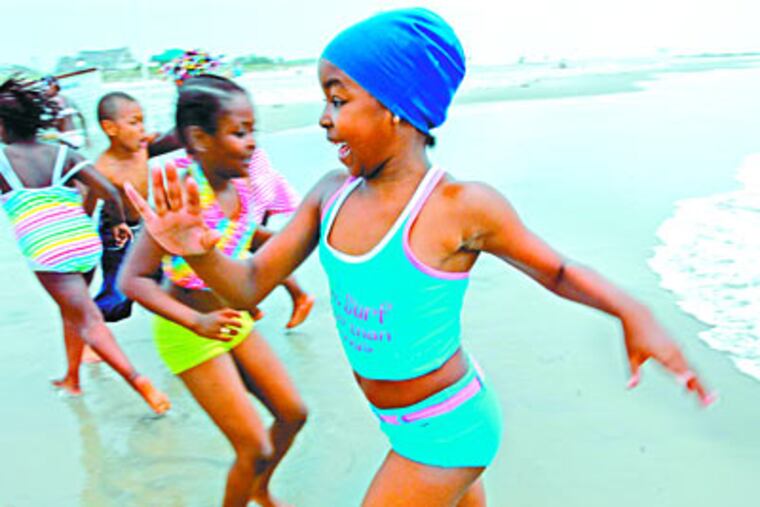Here's why toes are turning blue at Shore
ATLANTIC CITY - The temperatures may be steamy outside, but, baby, it's cold in the water. Just ask Melinda Castile, down the Shore for a week from Brooklyn, N.Y., and determined to go in the ocean no matter what the temperature. She bought a wetsuit.

ATLANTIC CITY - The temperatures may be steamy outside, but, baby, it's cold in the water.
Just ask Melinda Castile, down the Shore for a week from Brooklyn, N.Y., and determined to go in the ocean no matter what the temperature. She bought a wetsuit.
"I know it looks weird, but too bad. The water's freezing," said Castile, 28, as she emerged from the chilly surf near the Brighton Avenue beach.
Then there was Lacy Julius, 3, clad in a tiny red swimsuit, who burst into tears every time she ran into the surf Friday, then immediately ran back out, her tiny toes reddened by the icy-feeling water.
"She doesn't understand that it's too cold," said her mother, Denise, 26, of Bordentown, who tried to comfort the toddler - and keep her out of the water.
Up and down the Jersey Shore, tourists and locals alike have been lamenting ocean temperatures that have stayed in the 50s through most of June and the first two weeks of July, when the water typically is in the upper 60s or low 70s.
"It's cold, cold, cold," said Charlie Bowman, deputy chief of Ocean City's Beach Patrol. "We don't like it, but we deal with it. We have no choice."
Meteorologists blame "upwelling," a phenomenon that occurs when cold water from the ocean floor is pulled up and the warm surf - which commonly lies on the surface of waves during the summer - is pushed out to sea by southwest winds that blow parallel to the coast.
Upwelling occurs most often after the sea has warmed appreciably from early spring. But this year, the ocean here has never seemed to reach uniform warmth, and the cool water has lingered into the middle of July.
Oddly, just 40 miles to the south, in Cape May, the water briefly reached the low 70s last weekend, but dropped back down, according to the National Weather Service.
A week later, around 11 a.m., the water off Atlantic City was a chilly 58 degrees, while off Cape May it was charted at 65.
By afternoon, the water in Atlantic City had climbed to 64, while in Cape May it was inching closer to a normal 70.
"It really all depends on the wind. The southwest winds strip the 'skin' temperature off the ocean and carry the warm water out, away from the beach," said National Weather Service meteorologist Jim Eberwine, who began an intense study of upwelling when unusually cool ocean water off New Jersey plagued the summer of 1988.
On a single day that year, Aug. 19, the water at the Shore dropped 19 degrees, from 78 to 59. The average at the Shore that year was 63; the normal average is 68.
Eberwine forecasts that for at least the next week, continued southwest winds may bring more even upwelling.
He also predicted that big waves from Hurricane Bertha, now near Bermuda, may create rip currents off New Jersey that, coupled with the cool water, could mean problems for swimmers.
Theories about the cold water abound among tourists, who blame everything from melting Arctic glaciers and climate change to an old-fashioned cool spring and a Farmer's Almanac prediction of a warm fall.
But the professionals contend that upwelling - and the corresponding cold ocean - is quite common.
"The winds create a cascading effect as the water moves away from the coast," said Eberwine, who relies on data from satellites, coastal radar, and underwater weather stations to forecast weather.
Back in '88, some of what Eberwine and other experts surmised about upwelling was strictly theory. Without today's real-time satellite imagery, experts couldn't chart precisely how the warm water was pulling away from the coast toward the continental shelf. Or what effect ocean currents such as the cool Labrador Current or the warm Gulf Stream may have on the Jersey Shore, which is sandwiched between them.
But through advanced technology and an elaborate network of coastal sites feeding into data-monitoring stations - operated by the National Oceanic and Atmospheric Administration, the Davidson Laboratory at Stevens Institute of Technology, and Rutgers University - forecasters can get a better picture of the effects upwelling and other phenomena have on the Shore.
And the public, which can use the NOAA site, also can go to a Web site created with tourists in mind called www.thecoolroom.org, operated by Rutgers' Coastal Ocean Observation Laboratory.
Cold water at the beach does change tourists' habits - but only to a certain degree.
"They're still coming in and buying what they would normally buy, like suits and boards and things like that for the beach," said Dana Guerrina, women's buyer for Heritage Surf & Sport in Sea Isle City, Ocean City and Margate. "But we've seen a spike in wetsuit sales. People coming in to take surfing lessons or just going to the beach are buying them."
Scott Wall, a spokesman for the Borough of Avalon, said the town's beach patrol was reporting that the number of people going into the water seemed to be normal, but that the duration of their swims was much shorter.
"If they're on vacation, they want to be able to say they went in the water," Wall said. "But when it's cold, they get in and get out fast."
Not just beachgoers are affected. So are the creatures that naturally swim in the sea.
"I haven't seen one bluefish yet this summer," said Ralph Steeleman, 52, who said he had been fishing off Atlantic City his entire life. "The water's even too cold for them, I guess."